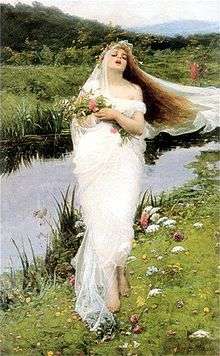Noè Bordignon
Noè Bordignon (September 3, 1841 – December 7, 1920) was an Italian painter, active mainly in Venice.

Noè Bordignon (1892)
Biography
He was born in Salvarosa near Castelfranco Veneto. He began studies in 1859 at the Accademia di Belle Arti of Venice, where he was a pupil of Michelangelo Grigoletti, Carlo De Blaas, and Pompeo Marino Molmenti. In 1865, he won a stipend to study in Rome. He later formed a strong friendship with Tranquillo Cremona. He favored painting genre scenes, in a style also favored by Giacomo Favretto, Luigi Nono (painter) and Alessandro Milesi. In 1869, he opened a studio in Venice.
He exhibited Le ragazze che cantano. In 1878 at Paris, he exhibited Costume romano; Il fuso della nonna ; Le pettegole: Un cortile a Venezia. In 1887 at Venice, he exhibited Fiori e dolci parole; Per l'America; Motti e Risate; Scarpette nuove; and Pater noster. He also painted frescoes and altarpieces.[1]
He died in San Zenone degli Ezzelini.
References
- Dizionario degli Artisti Italiani Viventi: pittori, scultori, e Architetti., by Angelo de Gubernatis. Tipe dei Successori Le Monnier, 1889, page 64.